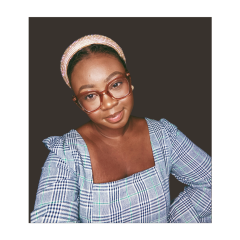
Art and the artist play a critical role in cultivating social justice. We connected with a Vancouver-based writer, artist, and curator Nya Lewis Williams to learn more. Nya provided the following statement:
“My name is Nya Lewis Williams, and I am grateful that the UBC Equity & Inclusion Office has asked me to share my perspectives on this topic. I am a Vancouver-based writer, artist, and curator, currently showing at the Vancouver Art Gallery & the Museum of Anthropology. I am the year-round programmer at Out on Screen, Vancouver Queer Film Festival, and an MFA student at OCAD University. My practice is rooted in self-study. I love to explore and actively archive the Black Canadian experience with all its intersections. I am a Queer first-generation Canadian of Caribbean heritage, and I approach curation like storytelling, with a strong sense of responsibility to the communities that create me.
On Black Art in Canada
“In 2017, I founded Black Art Gastown, an initiative dedicated to employing Black artists through curatorial work and community art facilitation. It has been a labor of love and, I believe, a necessary addition to the efforts to center the narratives and work of Black Canadian artists.
The legacy of Black artists in Canada is vast and decades long. It is severely under-documented and has been championed mostly by Black artists who feel a sense of belonging or duty to these histories. Nationwide, we owe a debt of gratitude to Black Film and Video Network, DAWA (Diasporic African Women’s Art Collective), the now dissolved Canadian Black Artists in Action, and the State of Blackness. These organizations and so many more work tirelessly chronicling Black Canadian artists, curators, and cultural producers and their contributions to Canadian art and, as an extension, social and political movements.”
On Challenges Faced by Black Artists
“One of the challenges Black artists often face is the burden of accountability. There is a silent (not at all silent) expectation of producing works with themes of racism, identity, identification, and belonging, so much so that it has become synonymous with Black artistry. Black artists in Canada have created a canon that is an affirmation of the nuance of the Black experience in all its forms. We owe it to Black artists to commit to addressing the complacency of non-Black artists and institutions in perpetuating the centering of Eurocentric standards of aesthetic and beauty, the systemic exclusion from public art spaces, lack of archives and improper documentation, as well as tokenism in hiring, displaying and acquisition practices.
Of course, there is no blanket experience for Black artists in Canada. Many artists like Stan Douglas and Lilian Allen have gone on to have extremely successful careers. But I believe we have not done enough to ensure these histories are accessible to the mainstream. We must acknowledge the challenges facing surrounding visibility and representation. When we challenge the perpetuation of these harmful actions, we challenge the colonial framework that upholds them. Art is a tool for social change. The role of the artist in dismantling anti-Black racism should shift as the needs of the community shift. It is a willingness to tell the truth, document the times, and give position and privilege in service to Black and Brown artists always.”
On Supporting Change and Engaging with Black Art
“Sustain your commitment to change by exploring Black artists in every genre: painting, sculpting, photography. Black artists are contributing their unique perspectives in all mediums. Support Black artist-run centers and engage by visiting exhibits, buying artwork, collecting, writing thorough reviews of their shows. Contribute to the ecosystem that supports the lifeline of commercial art.
Challenge the way you interact with Afro Diasporic culture. It is unavoidable! Much of what we acknowledge as contemporary art (especially in performance art) is rooted in African culture. The best way to advocate for Black artists is to bridge the respect, love, and consumption of Black art with the safety, respect, and love of Black people.”